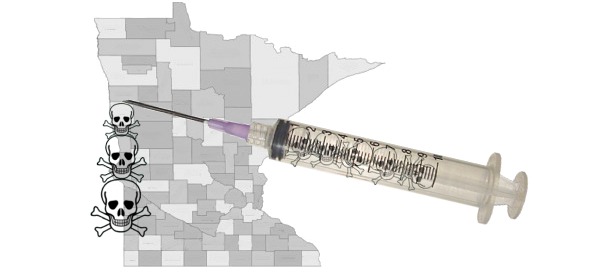Environment
Nanoparticles Added to Food, Drugs, and Vaccines Proven to Damage Health
 Nanoparticles, routinely and increasingly used in prepared foods and pharmaceutical drugs, have been found to damage the ability of chicken intestines to absorb nutrients, possibly including necessary vitamins, and to cause immune system activity.
Nanoparticles, routinely and increasingly used in prepared foods and pharmaceutical drugs, have been found to damage the ability of chicken intestines to absorb nutrients, possibly including necessary vitamins, and to cause immune system activity.
Nanoparticles had been presumed harmless, and their manufacture has ramped up to massive levels. They’re used everywhere. They’re in prepared foods and pharmaceutical drugs. A new study has demonstrated that these particles cause changes in the intestinal wall, interfere with iron absorption and likely other nutrients, and cause changes in the spleen and liver of chickens.
The journal Nature published the study and found its results to be worthy of concern. They’ve issued a statement saying:
The authors suggest that the polystyrene particles used in these experiments are generally considered to be non-toxic, but their interaction with a normal physiological process suggests a potential mechanism for a chronic, harmful, more subtle response.
The Study
Titled “Oral exposure to polystyrene nanoparticles affects iron absorption”, the study examined chickens fed a diet that included polystyrene nanoparticles, and also examined in vitro (in lab) samples of human intestinal epithelial lining. They found that a diet that includes polystyrene nanoparticles caused intestinal changes that affect the absorption of iron. The villi, microsopic projections in the intestinal wall through which nutrients are absorbed, were changed, resulting in an increased surface area in the gut.
The researchers showed changes in iron absorption and they anticipate that changes will also be found in absorption of calcium, copper, zinc and vitamins A, D, E and K—all necessary for life.
Iron absorption in chickens with short term exposure to nanoparticles was lower than in chickens either unexposed or chronically exposed. This likely explains why the intestinal villi of chronically exposed chickens had changed to create a larger surface area: to adjust for the loss of ability to absorb vital nutrients by growing more intestinal lining to absorb them.
Editorial Aside: This should serve as an object lesson to allopathic doctors. They define changes in the body—symptoms—as diseases. As this study demonstrates, symptoms are not diseases. They are the body’s adjustment to disease. However, we can be sure that, if a pathologist were to examine intestines and find an overgrowth of villi, as shown in this study:
- They would immediately be defined as pathological.
- The pharmaceutical corporations would be running around doing studies to find a drug to treat this new disease by reducing the “overgrowth” of villi.
- A name would, of course, be devised for this new “disease”, something like megavilli.
- Big Pharma would initiate a campaign of “public awareness” of megavilli.
- Finally, some drug would be sold at an exhorbitant price to a gullible public to treat megavilli..
Naturally, of course, the treatment itself would make the underlying problem worse by interfering with the absorption of nutrients. Ultimately, patients would die from lack of nutrition. Of course, doctors would declare that the disease of megavilli is the cause of death.
We should, at least, count our blessings that no pathologist noticed, so we aren’t now suffering under a false epidemic of megavilli.
But, Didn’t They Give Excess Doses of Nanoparticles?
The researchers made a point of feeding the chickens with a dose of nanoparticles equivalent to what most people in developed nations are exposed to every day. Therefore, the harm demonstrated in this study is a harm that is likely happening to everyone who routinely eats the prepared pseudo foods sold in supermarkets and ingests the drugs sold by drugstores and prescribed by doctors.
Other Pathological Changes
Look at the following image produced by the research. The top row is of samples of liver tissue from research chickens and the bottom is chicken spleen samples.
The chronically-exposed liver tissue (on the far right) shows accumulations of heterophils, as can be seen in the yellow circles. Heterophils are a type of antibody. Obviously, the nanoparticles are being seen as invaders, and the body is reacting to them.
The chronically-exposed spleen tissue shows a higher density of lymphoid follicles with active germinal centers. This is where B lymphocytes develop. Therefore, this demonstrates that nanoparticles stimulate an immune system response.
The Harm Done
Yet again, we are seeing the results of not adhering to the Precautionary Principle. The ability to create and utilize nanoparticles to make profits resulted in completely ignoring the risks. Rather than regulate them under the Food and Drug Administration, they’re regulated by the National Institute of Standards and Technology, a section of the Department of Commerce. [Admittedly, the FDA is not the regulatory agency it should be, but there wasn’t even an attempt to give the appearance of investigating nanoparticle safety issues.]
Nanoparticles commonly have a negatively charged surface, which allows them to easily adhere to cells in the gut and to accumulate in lymph tissues. This fact alone should have triggered alarm bells to stop their proliferation and first investigate safety. But that doesn’t serve the bottom line.
Since nanoparticles started to be manufactured on a large scale during the ’70s and ’80s, intestinal diseases like Crohn’s have skyrocketed from nearly unknown conditions to pandemic. It should also be noted that the study’s authors pointed out that Crohn’s has previously been linked to nanoparticles.
That these particles could be expected to cause harm was easily predictable. The fact is that such predictions were made—and, of course, ignored. This study shows that the predicted risks have, indeed, proven to be true.
Sources:
Tagged agribusiness, big pharma, conventional medicine, modern medicine, nanoparticles, nanoparticles chickens, nanoparticles drugs, nanoparticles food, nanoparticles pharmaceuticals, nature nanoparticles, pharmaceutical drugs, pharmaceuticals, pseudo-science, pseudoscience, science, vaccine, vaccines















Pingback: Nanoparticles Added to Food, Drugs, and Vaccines Proven to … – All about nano technology – NanoTechno.org